Click here for notable peacemakers in Austria. | Click here for peace monuments in Germany.
Click here for monuments related to Bertha von Suttner [1843-1924] in Austria & elsewhere.
Click here for "Sites of Memory: Markers, Memorials, Monuments & Cemeteries" by Mark R. Hatlie, Tübingen (Germany).
N.B. This web page has three parts: (1) Vienna (Austria), (2) the Remainder of Austria, and (3) Note about mahnmal & denkmal.
(1) Vienna (Austria) - 20 Peace Monuments
Right click image to enlarge / Zum Vergrößern auf das Bild klicken.


| P
A
NE
L |  1181 - "Noah Receiving the Dove," Augustinian Monastery, Vindobona, near Vienna (Austria). Part of panel #15 of 17 tripartite panels known as the Altar of Verdun. Created during the short interval between the 2nd and 3rd crusades. 1181 - "Noah Receiving the Dove," Augustinian Monastery, Vindobona, near Vienna (Austria). Part of panel #15 of 17 tripartite panels known as the Altar of Verdun. Created during the short interval between the 2nd and 3rd crusades.
|

| P A I N T I N G
 1819 - "Congress of Vienna," Musee du Louvre, Paris (France). By Jean-Baptiste Isabey [1767-1855]. "The Congress of Vienna was a conference of ambassadors of European states chaired by the Austrian statesman Klemens Wenzel von Metternich, and held in Vienna from September 1814 to June 1815." 1819 - "Congress of Vienna," Musee du Louvre, Paris (France). By Jean-Baptiste Isabey [1767-1855]. "The Congress of Vienna was a conference of ambassadors of European states chaired by the Austrian statesman Klemens Wenzel von Metternich, and held in Vienna from September 1814 to June 1815." 
|
 | M
U
SE
U
M |  1927 - Esperanto Museum, Österreichische Nationalbibliothek / Austrian National Library, Palais Mollard, 1 Herrengasse 9, Vienna (Austria). "Biggest collection of artificial languages in the world and a linguistic research library for language planning." 1927 - Esperanto Museum, Österreichische Nationalbibliothek / Austrian National Library, Palais Mollard, 1 Herrengasse 9, Vienna (Austria). "Biggest collection of artificial languages in the world and a linguistic research library for language planning."
|

| B
E
LL |  1951 - "The Pummerin," North Tower, Stephansdom / St. Stephen's Cathedral, Wien/Vienna (Austria).
"By the Turks guns originating from material and its casting in the early days of the Second Republic, it is also a symbol of peace, freedom and the country as a gift from the province of Upper Austria for the St. Stephen's Cathedral was destroyed in World War II as a symbol of the reconstruction [Google translation]." Called "The Voice of Austria." At 21,383 kg, the third largest bell in Western & Central Europe, after St. Petersglocke in Cologne Cathedral (24.000 kg) and Maria Dolens (qv) in Rovereto, Italy (23.000 kg). 1951 - "The Pummerin," North Tower, Stephansdom / St. Stephen's Cathedral, Wien/Vienna (Austria).
"By the Turks guns originating from material and its casting in the early days of the Second Republic, it is also a symbol of peace, freedom and the country as a gift from the province of Upper Austria for the St. Stephen's Cathedral was destroyed in World War II as a symbol of the reconstruction [Google translation]." Called "The Voice of Austria." At 21,383 kg, the third largest bell in Western & Central Europe, after St. Petersglocke in Cologne Cathedral (24.000 kg) and Maria Dolens (qv) in Rovereto, Italy (23.000 kg).
|

 | B
U
ST |  1953 - Bust of Heinrich Lammasch, The Arkadenhof, University of Vienna, Vienna (Austria). Heinrich Lammasch [1853-1920] was a great Austrian peacemaker: Professor of Penal Law & International Law, & scholar/publicist, as well as active as diplomat (& the last prime minister of imperial Austria). He had strong links with the peace movement. As "a member of the Hague Arbitration Tribunal,... he arranged the Newfoundland dispute between Great Britain & the USA [in 1910]." Information courtesy of Peter van den Dungen. 1953 - Bust of Heinrich Lammasch, The Arkadenhof, University of Vienna, Vienna (Austria). Heinrich Lammasch [1853-1920] was a great Austrian peacemaker: Professor of Penal Law & International Law, & scholar/publicist, as well as active as diplomat (& the last prime minister of imperial Austria). He had strong links with the peace movement. As "a member of the Hague Arbitration Tribunal,... he arranged the Newfoundland dispute between Great Britain & the USA [in 1910]." Information courtesy of Peter van den Dungen.
|
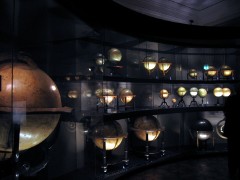 | M
U
SE
U
M |  1956 - the Globe Museum, Österreichische Nationalbibliothek / Austrian National Library, Palais Mollard, 1 Herrengasse 9, Vienna (Austria). Collection of more than 400 globes, 240 of which are on display, including early modern globes by Mercator, Blaeu & Coronelli.
Reopened in larger space on December 1, 2005. Click here for description of a visit in December 2001. 1956 - the Globe Museum, Österreichische Nationalbibliothek / Austrian National Library, Palais Mollard, 1 Herrengasse 9, Vienna (Austria). Collection of more than 400 globes, 240 of which are on display, including early modern globes by Mercator, Blaeu & Coronelli.
Reopened in larger space on December 1, 2005. Click here for description of a visit in December 2001.
|

| O F F I C E S
 August 23, 1979 - Vienna International Centre (VIC), UN Office at Vienna (UNOV), Vienna (Austria). Includes headquarters of the International Atomic Energy Agency (IAEA) and the UN Industrial Development Organization (UNIDO), respectively in Vienna since 1957 and 1967. August 23, 1979 - Vienna International Centre (VIC), UN Office at Vienna (UNOV), Vienna (Austria). Includes headquarters of the International Atomic Energy Agency (IAEA) and the UN Industrial Development Organization (UNIDO), respectively in Vienna since 1957 and 1967. 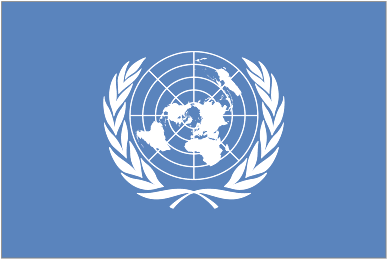
|

|  1983 - Replica of the Code of Hammurabi," International Atomic Energy Agency (IAEA), Vienna International Centre (VIC), Vienna (Austria). "The Code of Law Stele of Hammurabi is a well-preserved Babylonian law code, dating to ca. 1700 B.C. The original stele today is on display in the Louvre Museum in Paris (France). The replica, a gypsum cast, was donated to the IAEA by Iraq in 1983 on the occasion of the 25th Anniversary of the Agency.
The sixth Babylonian king, Hammurabi [1792-1750 BC], enacted the code, and partial copies exist on a human-sized stone stele and on various clay tablets. The Code consists of 282 laws, with punishments like 'an eye for an eye, a tooth for a tooth,' also known as lex talionis. The Code is inscribed in the Akkadian language, using cuneiform script carved into the stele.
This Law was written before the Mosaic Code and was one of the first written laws in the world. The Code of Hammurabi was written on a stele, a large stone monument, and placed in a public place so that all could see it. The stele was later plundered by the Elamites in the 12th century BC and removed to their capital, Susa, Elam (now Khuzestan, Iran); it was rediscovered there in 1901 by the Egyptologist Gustave Jéquier. " 1983 - Replica of the Code of Hammurabi," International Atomic Energy Agency (IAEA), Vienna International Centre (VIC), Vienna (Austria). "The Code of Law Stele of Hammurabi is a well-preserved Babylonian law code, dating to ca. 1700 B.C. The original stele today is on display in the Louvre Museum in Paris (France). The replica, a gypsum cast, was donated to the IAEA by Iraq in 1983 on the occasion of the 25th Anniversary of the Agency.
The sixth Babylonian king, Hammurabi [1792-1750 BC], enacted the code, and partial copies exist on a human-sized stone stele and on various clay tablets. The Code consists of 282 laws, with punishments like 'an eye for an eye, a tooth for a tooth,' also known as lex talionis. The Code is inscribed in the Akkadian language, using cuneiform script carved into the stele.
This Law was written before the Mosaic Code and was one of the first written laws in the world. The Code of Hammurabi was written on a stele, a large stone monument, and placed in a public place so that all could see it. The stele was later plundered by the Elamites in the 12th century BC and removed to their capital, Susa, Elam (now Khuzestan, Iran); it was rediscovered there in 1901 by the Egyptologist Gustave Jéquier. "  
|
  

| M A H N M A L
 November 24, 1988 - Mahnmal gegen Krieg und Faschismus / Monument Against War & Fascism, Albertinaplatz, Vienna (Austria). By Austrian artist Alfred Hrdlicka [1928-2009]. This square is the site of a massacre in 1945 when an Allied bomb killed an unknown number of civilians taking shelter in the basement of a building. "Immensely controversial. No distinction among different groups who died in WW-II. Lead directly to the campaign for the 2000 Judenplatz memorial [qv]." See Winstone (2010), page 135. November 24, 1988 - Mahnmal gegen Krieg und Faschismus / Monument Against War & Fascism, Albertinaplatz, Vienna (Austria). By Austrian artist Alfred Hrdlicka [1928-2009]. This square is the site of a massacre in 1945 when an Allied bomb killed an unknown number of civilians taking shelter in the basement of a building. "Immensely controversial. No distinction among different groups who died in WW-II. Lead directly to the campaign for the 2000 Judenplatz memorial [qv]." See Winstone (2010), page 135.
|

| P
L
O
W |  1994 - Sculpture "Swords into Ploughshares," International Atomic Energy Agency (IAEA), Vienna International Centre (VIC), Vienna (Austria).
"This sculpture, made out of non-nuclear material from a dismantled nuclear device, symbolizes the commitment to the non-proliferation of nuclear weapons. It was donated to the IAEA by the Republic of South Africa in 1994.
'And they shall beat their swords into ploughshares, and their spears into pruning hooks. Nation shall not lift up sword against nation, neither shall they learn war any more.' (Quotation from Isaiah 2:4)
Although this is the smallest sculpture at the UN Vienna, it is by no means the least important." 1994 - Sculpture "Swords into Ploughshares," International Atomic Energy Agency (IAEA), Vienna International Centre (VIC), Vienna (Austria).
"This sculpture, made out of non-nuclear material from a dismantled nuclear device, symbolizes the commitment to the non-proliferation of nuclear weapons. It was donated to the IAEA by the Republic of South Africa in 1994.
'And they shall beat their swords into ploughshares, and their spears into pruning hooks. Nation shall not lift up sword against nation, neither shall they learn war any more.' (Quotation from Isaiah 2:4)
Although this is the smallest sculpture at the UN Vienna, it is by no means the least important."  
|

| B
E
L
L |  1995 - United Nations Peace Bell, Vienna
International Centre (VIC), Vienna (Austria). Cast in Japan. 1995 - United Nations Peace Bell, Vienna
International Centre (VIC), Vienna (Austria). Cast in Japan.  
|
![]()
|  September 9, 2009 - Hiroshima Peace Monument, Ottakring District, Vienna (Austria). "Some 100 people from Japan and Austria attended the unveiling Wednesday of a stone peace monument featuring a flagstone that was exposed to radiation in the 1945 U.S. atomic bombing of Hiroshima.
The Vienna monument is linked with a children's peace monument in Hiroshima's Peace Memorial Park that is dedicated to Sadako Sasaki [1943-1955], a girl exposed to atomic radiation at the age of 2 & who died at age 12 from a radiation-caused illness. Austrian children's writer Karl Bruckner [1906-1982] authored "Sadako will leben" ("The Day of the Bomb") in 1961 with Sasaki as its heroine. The book has been translated into more than 20 languages. Citizens' groups in Hiroshima & Vienna decided to build the stone monument in the Austrian capital's Ottakring district, Bruckner's home area, to mark the 140th anniversary of the establishment of diplomatic ties between Japan & Austria.
The Hiroshima Municipal Government contributed the flagstone from Hiroshima's old City Hall. It measures 180 cm high & weighs about 800 kg. It is inscribed with the words "world peace" in Japanese & German." September 9, 2009 - Hiroshima Peace Monument, Ottakring District, Vienna (Austria). "Some 100 people from Japan and Austria attended the unveiling Wednesday of a stone peace monument featuring a flagstone that was exposed to radiation in the 1945 U.S. atomic bombing of Hiroshima.
The Vienna monument is linked with a children's peace monument in Hiroshima's Peace Memorial Park that is dedicated to Sadako Sasaki [1943-1955], a girl exposed to atomic radiation at the age of 2 & who died at age 12 from a radiation-caused illness. Austrian children's writer Karl Bruckner [1906-1982] authored "Sadako will leben" ("The Day of the Bomb") in 1961 with Sasaki as its heroine. The book has been translated into more than 20 languages. Citizens' groups in Hiroshima & Vienna decided to build the stone monument in the Austrian capital's Ottakring district, Bruckner's home area, to mark the 140th anniversary of the establishment of diplomatic ties between Japan & Austria.
The Hiroshima Municipal Government contributed the flagstone from Hiroshima's old City Hall. It measures 180 cm high & weighs about 800 kg. It is inscribed with the words "world peace" in Japanese & German." 
|

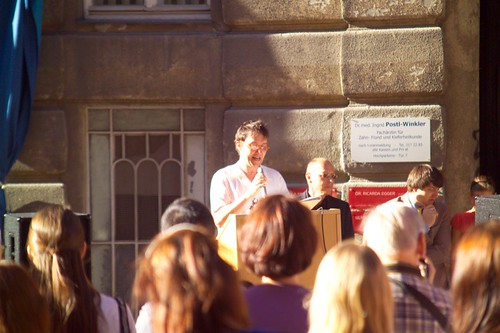
 | P
L
A
Q
U
E |  May 25, 2011 - Memorial plaque for Alfred Hermann Fried, Widerhofergasse 5, 9th district, Vienna (Austria). Fried [1864-1921] was an Austrian Jewish pacifist, publicist, journalist & co-founder of the German peace movement. Shared Nobel prize with Tobias Asser) [1838-1913]. The plaque is "his first Memorial in Vienna... More than 200 people and took part in the ceremony. Klaus Maria Brandauer unveiled the commemorative plaque at the fountain Hevenu Shalom choir sang." Google translation: "... Europe is not the affair of an individual State...
/ ORGANIZE THE WORLD!
/ ALREFD HERMANN FRIED
/ * November 11, 1864 in Vienna. + 4 May 1921 in same place.
/ Lived in this house when he was awarded the Nobel Peace Prize in 1911.
/ He is considered the founder of peace research.
/ This marks the 100th Anniversary of the Nobel Peace Prize ceremony." /// Info & image courtesy of Peter van den Dungen. May 25, 2011 - Memorial plaque for Alfred Hermann Fried, Widerhofergasse 5, 9th district, Vienna (Austria). Fried [1864-1921] was an Austrian Jewish pacifist, publicist, journalist & co-founder of the German peace movement. Shared Nobel prize with Tobias Asser) [1838-1913]. The plaque is "his first Memorial in Vienna... More than 200 people and took part in the ceremony. Klaus Maria Brandauer unveiled the commemorative plaque at the fountain Hevenu Shalom choir sang." Google translation: "... Europe is not the affair of an individual State...
/ ORGANIZE THE WORLD!
/ ALREFD HERMANN FRIED
/ * November 11, 1864 in Vienna. + 4 May 1921 in same place.
/ Lived in this house when he was awarded the Nobel Peace Prize in 1911.
/ He is considered the founder of peace research.
/ This marks the 100th Anniversary of the Nobel Peace Prize ceremony." /// Info & image courtesy of Peter van den Dungen.
|
 |
 October 28-29, 2011 - "Symposium zu Friedensaktivist Fried / Sympossium on Peaceactivist Fried," Town Hall, Friedrich-Ebert-Strasse, Potsdam (Germany). "Who knows the German Peace Prize? In Potsdam, Bertha von Suttner is still present, less their long-time employee and later winner Alfred Hermann Fried. The Vienna-born peace activist, founded in 1892 with her ??along the German Peace Society and 'The peace waiting.' The monthly magazine quickly developed into an important organ of the peace movement. 100 years after the [Nobel] award ceremony, organized by the International Peace Bureau (IPB) in cooperation with the Working Group Historical Peace Research (AKHF), Bertha von Suttner Foundation of the German Peace Society & the United War Resisters (DFG-VK) a two-day symposium on 'Organize the world! The Nobel Peace Prize laureate Alfred Hermann Fried (1864-1921): Life, work and lasting impact.' [Google translation]" Click here for final symposium program in German & English (PDF file). October 28-29, 2011 - "Symposium zu Friedensaktivist Fried / Sympossium on Peaceactivist Fried," Town Hall, Friedrich-Ebert-Strasse, Potsdam (Germany). "Who knows the German Peace Prize? In Potsdam, Bertha von Suttner is still present, less their long-time employee and later winner Alfred Hermann Fried. The Vienna-born peace activist, founded in 1892 with her ??along the German Peace Society and 'The peace waiting.' The monthly magazine quickly developed into an important organ of the peace movement. 100 years after the [Nobel] award ceremony, organized by the International Peace Bureau (IPB) in cooperation with the Working Group Historical Peace Research (AKHF), Bertha von Suttner Foundation of the German Peace Society & the United War Resisters (DFG-VK) a two-day symposium on 'Organize the world! The Nobel Peace Prize laureate Alfred Hermann Fried (1864-1921): Life, work and lasting impact.' [Google translation]" Click here for final symposium program in German & English (PDF file).
|
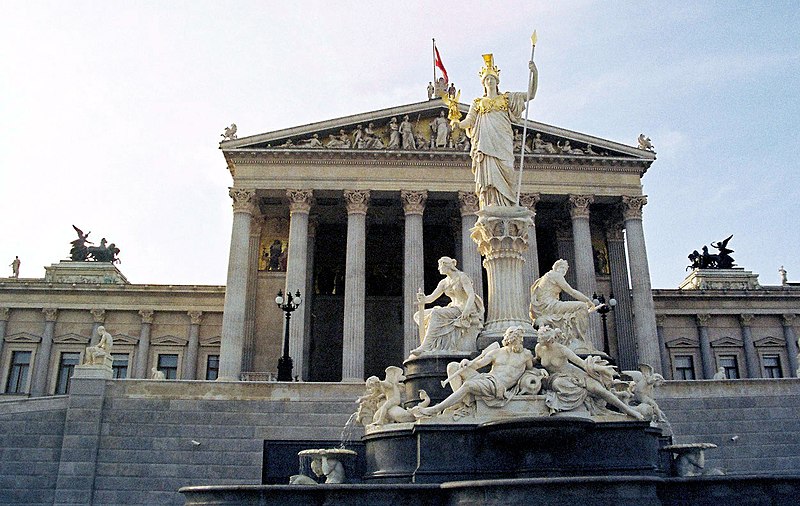
 |
 December 1, 2011 - "A second seminar on Fried is due to be held in the Austrian Parliament, Vienna (Austria), on Dec 1st, 2011." /// "There will be a panel discussion, with Jalka, Peter van den Dungen &
Walter Goehring, on why Nobel peace laureates are so quickly forgotten, on
the occasion of the Fried year." December 1, 2011 - "A second seminar on Fried is due to be held in the Austrian Parliament, Vienna (Austria), on Dec 1st, 2011." /// "There will be a panel discussion, with Jalka, Peter van den Dungen &
Walter Goehring, on why Nobel peace laureates are so quickly forgotten, on
the occasion of the Fried year."
|
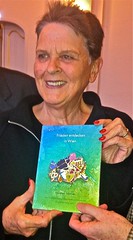
 | T
R
A
I
L |
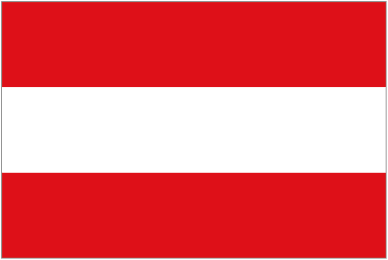 December 1, 2011 - "Wiener Friedenspfade / Vienna peace paths," Vienna (Austria). Suggested by Peter van den Dungen & developed by Suzanne Jalka, the "head" of the Quakers in German-speaking Europe. Image shows Jalka & the trail guide, "Frieden entdecken in Wien / Discovering peace in Vienna," 200 pages (with separate map in pocket inside the back cover), written by Jalka & two co-authors, to be launched December 1 at the Austrian Parliament. "Jalka lives in Cak (Hungary) & works again in her native Vienna (Austria) as a conflict consultant & author." /// The trail undoubtedly includes the Congress of Vienna in 1814-15, Bertha von Suttner [1843-1914], Alfred Fried [1864-1921], and the inauguration of the Universal Peace Federation (UPF) in 2005. /// Information courtesy of Peter van den Dungen. Photo from Andreas Landl, the peace journalist from Vienna. December 1, 2011 - "Wiener Friedenspfade / Vienna peace paths," Vienna (Austria). Suggested by Peter van den Dungen & developed by Suzanne Jalka, the "head" of the Quakers in German-speaking Europe. Image shows Jalka & the trail guide, "Frieden entdecken in Wien / Discovering peace in Vienna," 200 pages (with separate map in pocket inside the back cover), written by Jalka & two co-authors, to be launched December 1 at the Austrian Parliament. "Jalka lives in Cak (Hungary) & works again in her native Vienna (Austria) as a conflict consultant & author." /// The trail undoubtedly includes the Congress of Vienna in 1814-15, Bertha von Suttner [1843-1914], Alfred Fried [1864-1921], and the inauguration of the Universal Peace Federation (UPF) in 2005. /// Information courtesy of Peter van den Dungen. Photo from Andreas Landl, the peace journalist from Vienna.
|
 | P
L
A
Q
U
E |  July 27, 2012 - Plaque commemorating Count Richard Graf Coudenhove-Kalergi, Heiligen Kreuzer-Hof, Vienna (Austria). Google translation: "In this house, in the Pralatur Heiligenkreuzerhof lived the founder of the PanEuropean Union and spiritual father of the European agreement, RICHARD GRAF COUDENHOVE-KALERGI. From here, he fled in the night of 11 to 12 March 1938 the occupation forces of Nazi Germany. Austrian Pan European Association. To mark the 40 anniversary of his death on 27 July 2012." /// "Coudenhove-Kalergi, born November 16, 1894, in Tokyo (Japan); died July 27, 1972 in Schruns (Austria), was a Japanese Austrian writer, politician & founder of the Paneuropa movement." Information courtesy of Peter van den Dungen. July 27, 2012 - Plaque commemorating Count Richard Graf Coudenhove-Kalergi, Heiligen Kreuzer-Hof, Vienna (Austria). Google translation: "In this house, in the Pralatur Heiligenkreuzerhof lived the founder of the PanEuropean Union and spiritual father of the European agreement, RICHARD GRAF COUDENHOVE-KALERGI. From here, he fled in the night of 11 to 12 March 1938 the occupation forces of Nazi Germany. Austrian Pan European Association. To mark the 40 anniversary of his death on 27 July 2012." /// "Coudenhove-Kalergi, born November 16, 1894, in Tokyo (Japan); died July 27, 1972 in Schruns (Austria), was a Japanese Austrian writer, politician & founder of the Paneuropa movement." Information courtesy of Peter van den Dungen.

|
(2) Remainder of Austria - 25 Peace Monuments

 |  1807 - Peace of Pressburg Column, Klagenfurt am Wörthersee, Carinthia (Austria). Google translation: "The slim and about 20 meters high column of Salzburg marble was created in 1807 by the South Tyrolean master sculptor Johann Probst. You should remember the Peace of Pressburg between Austria and Napoleon (1805), and was donated by Cardinal Franz Xaver Altgraf of Salm-Reifferscheidt Herb home. Cardinal Salm, Prince-Bishop of Gurk, was during the first ascent of the highest mountain in Austria, the Grossglockner (27 July 1800), the process and gained high earnings during the occupation by the French in Klagenfurt.
The obelisk bears on its head as a symbolic peace sign cross and palm trees...." 1807 - Peace of Pressburg Column, Klagenfurt am Wörthersee, Carinthia (Austria). Google translation: "The slim and about 20 meters high column of Salzburg marble was created in 1807 by the South Tyrolean master sculptor Johann Probst. You should remember the Peace of Pressburg between Austria and Napoleon (1805), and was donated by Cardinal Franz Xaver Altgraf of Salm-Reifferscheidt Herb home. Cardinal Salm, Prince-Bishop of Gurk, was during the first ascent of the highest mountain in Austria, the Grossglockner (27 July 1800), the process and gained high earnings during the occupation by the French in Klagenfurt.
The obelisk bears on its head as a symbolic peace sign cross and palm trees...."
|


 |  May 3, 1975 - Mauthausen-Gusen Concentration Camp, Mauthausen & Gusen (Austria). Center of a group of SS slave labor camps. Original inmates were largely Germans who had resisted the Nazi regime, notable communists, socialists, and religious dissenters. Thirty years after liberation Chancellor Bruno Kreisky officially opened the Mauthausen Museum. Many of the sub-camps near Gusen are now covered by residential areas built after the war. In February 2009 the memorial was vandalized by persons unknown, who defaced a section of the wall with anti-Islamic graffiti. Right image shows a 1978 East German postage stamp. May 3, 1975 - Mauthausen-Gusen Concentration Camp, Mauthausen & Gusen (Austria). Center of a group of SS slave labor camps. Original inmates were largely Germans who had resisted the Nazi regime, notable communists, socialists, and religious dissenters. Thirty years after liberation Chancellor Bruno Kreisky officially opened the Mauthausen Museum. Many of the sub-camps near Gusen are now covered by residential areas built after the war. In February 2009 the memorial was vandalized by persons unknown, who defaced a section of the wall with anti-Islamic graffiti. Right image shows a 1978 East German postage stamp. 

|
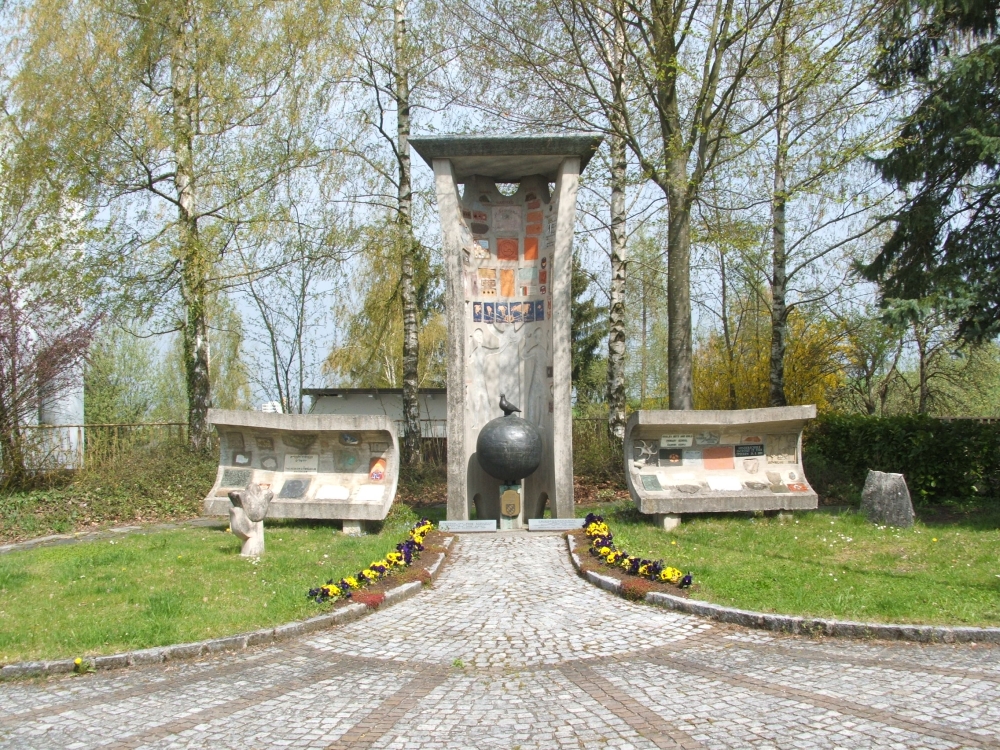

|  1977 - Peace Monument, Sankt Ulrich (Austria). "Austria's First Peace Monument. On the occasion of St. Ulricher Kulturtage 1977 the first peace monument in Austria was built in Ortisei.
From 70 countries of the world, building blocks were sent. The sculptor Prof. Alois Dorn shaped the building blocks to a four-and-a-half-meter-high, narrow column.
All stones were poured into them, so that the semicircular inner wall shows the face of the stones.
Furthermore a bronze world globe with a peace dove was introduced [Google translation]." One of 15 peace monuments found in July 2017 by Googling "Friedensdenkmal" or "Friedensmahnmal." GLOBE DOVE 1977 - Peace Monument, Sankt Ulrich (Austria). "Austria's First Peace Monument. On the occasion of St. Ulricher Kulturtage 1977 the first peace monument in Austria was built in Ortisei.
From 70 countries of the world, building blocks were sent. The sculptor Prof. Alois Dorn shaped the building blocks to a four-and-a-half-meter-high, narrow column.
All stones were poured into them, so that the semicircular inner wall shows the face of the stones.
Furthermore a bronze world globe with a peace dove was introduced [Google translation]." One of 15 peace monuments found in July 2017 by Googling "Friedensdenkmal" or "Friedensmahnmal." GLOBE DOVE
|


|  Date? - Ereignisdenkmal, Friedensdenkmal d. Siedlung Friedensstadt
Denkmalschutz-AT.svg Austria Bundesadler.svg This media shows the protected monument with the number 75669 in Austria. One of 15 peace monuments found in July 2017 by Googling "Friedensdenkmal" or "Friedensmahnmal." Date? - Ereignisdenkmal, Friedensdenkmal d. Siedlung Friedensstadt
Denkmalschutz-AT.svg Austria Bundesadler.svg This media shows the protected monument with the number 75669 in Austria. One of 15 peace monuments found in July 2017 by Googling "Friedensdenkmal" or "Friedensmahnmal."
|


|  Date? - Friedenskreuz/Peace Cross, on the Oberkaibling [Mountain], Pettenbach, Oberösterreich (Austria). "From the branch church of Heiligenleithen, south of Pettenbach, the path leads to the Friedenskreuz/Peace Cross on the Oberkaibling [Mountain], from where you have a beautiful view of the Upper Austrian Pre-Alps & the picturesque Alpine valley. One of 15 peace monuments found in July 2017 by Googling "Friedensdenkmal" or "Friedensmahnmal."
/// Image shows "50 Jahre Friedenskreuz am Oberkaibling." Date? - Friedenskreuz/Peace Cross, on the Oberkaibling [Mountain], Pettenbach, Oberösterreich (Austria). "From the branch church of Heiligenleithen, south of Pettenbach, the path leads to the Friedenskreuz/Peace Cross on the Oberkaibling [Mountain], from where you have a beautiful view of the Upper Austrian Pre-Alps & the picturesque Alpine valley. One of 15 peace monuments found in July 2017 by Googling "Friedensdenkmal" or "Friedensmahnmal."
/// Image shows "50 Jahre Friedenskreuz am Oberkaibling."
|


|  Date? - Landeplatz des Friedens, Kirchenplatz/Church Square, Peuerbach, Oberösterreich (Austria). Herbert Egger, 2008; Stelenprofile stellen die Friedenstaube dar / Landing place of the
Peace, Herbert Egger, 2008; Steles provide the
Peace doves. One of 15 peace monuments found in July 2017 by Googling "Friedensdenkmal" or "Friedensmahnmal." Date? - Landeplatz des Friedens, Kirchenplatz/Church Square, Peuerbach, Oberösterreich (Austria). Herbert Egger, 2008; Stelenprofile stellen die Friedenstaube dar / Landing place of the
Peace, Herbert Egger, 2008; Steles provide the
Peace doves. One of 15 peace monuments found in July 2017 by Googling "Friedensdenkmal" or "Friedensmahnmal."
|



|  Date? -
Denkmal für den Weltfrieden / Monument for World Peace, Platz des Friedens, on Achalm [Mountain], Reutlingen, Baden-Württemberg (Germany).
Ein Denkmal für den Weltfrieden auf der Achalm. "Peace monument on the square of peace on the Achalm. A monument to world peace on the Achalm." /// "In the Name of Peace.
'The flame of peace /
A symbol of global peace /
In memory of our mission /
To work for peace /
In thought, words, and deeds."
/// "The Flame of Peace / Flamme des Friedens is an award granted by the Austrian non-profit organization Vereins zur Förderung des Friedens / Association for the Promotion of Peace, which promotes world peace. The flame is represented by a wood carving mounted on a stone base. The organization gives out awards to prominent people, peace activists & organizations for their activity in promoting peace. ///
Her Imperial Royal Highness Princess Herta Margarete of Hapsburg-Lorraine, Archduke of Austria, Princess of Tuscany, Princess of Hungary, Princess of Bohemia, Princess of Croatia, President of the Flame of Peace [Google translation]." /// "Sample Monuments" erected at Schloss Wilhelminenberg in Vienna (Austria), March 2009; Sana'a (Yemen), September 2009; Mitterdorf (Austria), March 14, 2012; and Ernstbrunn (Austria), May 26, 2012. Date? -
Denkmal für den Weltfrieden / Monument for World Peace, Platz des Friedens, on Achalm [Mountain], Reutlingen, Baden-Württemberg (Germany).
Ein Denkmal für den Weltfrieden auf der Achalm. "Peace monument on the square of peace on the Achalm. A monument to world peace on the Achalm." /// "In the Name of Peace.
'The flame of peace /
A symbol of global peace /
In memory of our mission /
To work for peace /
In thought, words, and deeds."
/// "The Flame of Peace / Flamme des Friedens is an award granted by the Austrian non-profit organization Vereins zur Förderung des Friedens / Association for the Promotion of Peace, which promotes world peace. The flame is represented by a wood carving mounted on a stone base. The organization gives out awards to prominent people, peace activists & organizations for their activity in promoting peace. ///
Her Imperial Royal Highness Princess Herta Margarete of Hapsburg-Lorraine, Archduke of Austria, Princess of Tuscany, Princess of Hungary, Princess of Bohemia, Princess of Croatia, President of the Flame of Peace [Google translation]." /// "Sample Monuments" erected at Schloss Wilhelminenberg in Vienna (Austria), March 2009; Sana'a (Yemen), September 2009; Mitterdorf (Austria), March 14, 2012; and Ernstbrunn (Austria), May 26, 2012.  One of 15 peace monuments found in July 2017 by Googling "Friedensdenkmal" or "Friedensmahnmal." FLAMES One of 15 peace monuments found in July 2017 by Googling "Friedensdenkmal" or "Friedensmahnmal." FLAMES
|


 | S
T
A
T
U
E |   1987 - Statue of Franz Jägerstätter, Saint Malachy Church, North Philadelphia, Pennsylvania (USA). "Why, given the awe-inspiring calendar of saints, is St. Malachy so taken with a virtually unknown Austrian peasant from WW-II times? In God’s providence & with the generosity of Fr. Daniel Berrigan, we possess on a side altar a magnificent carved statue of [Franz] Jägerstätter. The artist, Bob McGovern [1933-2011], one of our fellow parishoners, carved the statue to honor Fr. Dan’s fifty years as a Jesuit in 1987. Fr. Berrigan has great devotion to Jägerstätter, but stripping down in his mid-eighties, donated the statue to St. Malachy as a place where the peace of Christ will be celebrated." Info courtesy of Gerard Lössbroek (Pax Christi International). 1987 - Statue of Franz Jägerstätter, Saint Malachy Church, North Philadelphia, Pennsylvania (USA). "Why, given the awe-inspiring calendar of saints, is St. Malachy so taken with a virtually unknown Austrian peasant from WW-II times? In God’s providence & with the generosity of Fr. Daniel Berrigan, we possess on a side altar a magnificent carved statue of [Franz] Jägerstätter. The artist, Bob McGovern [1933-2011], one of our fellow parishoners, carved the statue to honor Fr. Dan’s fifty years as a Jesuit in 1987. Fr. Berrigan has great devotion to Jägerstätter, but stripping down in his mid-eighties, donated the statue to St. Malachy as a place where the peace of Christ will be celebrated." Info courtesy of Gerard Lössbroek (Pax Christi International).  
|



|  April 20, 1989 - Hitler's Birthplace, Salzburger Vorstadt, Braunau am Inn (Austria). The former Gasthof zum Pommer or Gasthof des Josef Pommer. Original address was Salzburger Vorstadt 219 when Adolf Hitler was born here at 6:30 p.m. on April 20, 1889, Easter Sunday. House is is unmarked, except for a large stone of Mauthausen granite which was placed on 100th anniversary of Hitler's birth. English translation: "For peace, freedom and democracy, never again Fascism, millions of dead admonish." April 20, 1989 - Hitler's Birthplace, Salzburger Vorstadt, Braunau am Inn (Austria). The former Gasthof zum Pommer or Gasthof des Josef Pommer. Original address was Salzburger Vorstadt 219 when Adolf Hitler was born here at 6:30 p.m. on April 20, 1889, Easter Sunday. House is is unmarked, except for a large stone of Mauthausen granite which was placed on 100th anniversary of Hitler's birth. English translation: "For peace, freedom and democracy, never again Fascism, millions of dead admonish." 
|


| S
T
A
M
P
|  1989 - Postage stamp (Austria) honoring Alfred Hermann Fried [1864-1921] who received the Nobel Peace Prize in 1911. 1989 - Postage stamp (Austria) honoring Alfred Hermann Fried [1864-1921] who received the Nobel Peace Prize in 1911.
|
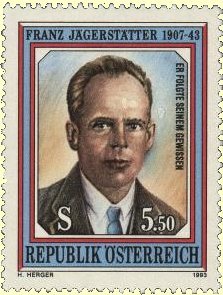

| S
T
A
M
P |  1993 -
Postage stamp (Austria). "For the 50th Anniversary of the resistance fighter Franz
Jägerstätter" (Österrreichische Briefmarke zum 50. Todestag des Widerstandskämpfers Franz Jägerstätter). 1993 -
Postage stamp (Austria). "For the 50th Anniversary of the resistance fighter Franz
Jägerstätter" (Österrreichische Briefmarke zum 50. Todestag des Widerstandskämpfers Franz Jägerstätter).
|
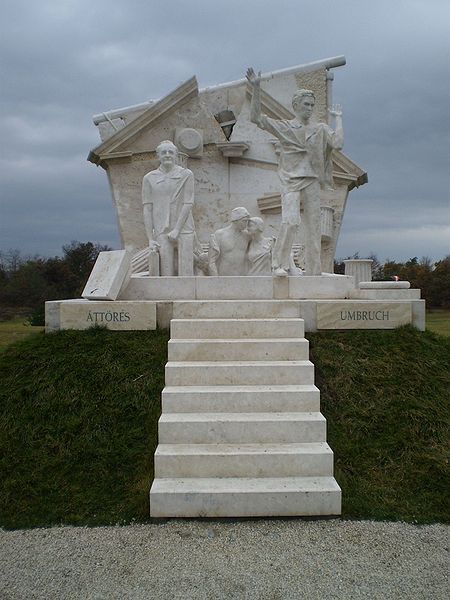  

|  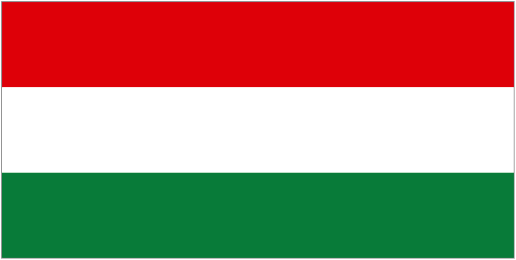 About 1991 - Monuments celebrating the Pan-European Picnic, Sopron (Austria/Hungary). "The Pan-European Picnic / Paneuropäisches Picknick / páneurópai piknik was a peace demonstration held on the Austrian-Hungarian border near the town of Sopron on 19 August 1989, an important event during the Revolutions of 1989 that led to the fall of the Iron Curtain & the reunification of Germany... The place of the picnic is marked by a monument of Miklós Melocco [left image], by a bell presented from the city of Debrecen (Hungary) from where the idea of the Picnic emerged, a pagoda presented by the Association of the Japanese–Hungarian Friendship and by a wooden monument unveiled by the organisors [sic] in 1991. A large artwork made by Gabriela von Habsburg, a daughter of Otto von Habsburg, & symbolizing a Cross & a barbed wire [right image] can be found at the Cave Theatre of Fertorakos (Hungary), a few kilometres from the site. Hungarian President László Sólyom unveiled a white marble monument in memory of those who had risked their life to cross the Iron Curtain." About 1991 - Monuments celebrating the Pan-European Picnic, Sopron (Austria/Hungary). "The Pan-European Picnic / Paneuropäisches Picknick / páneurópai piknik was a peace demonstration held on the Austrian-Hungarian border near the town of Sopron on 19 August 1989, an important event during the Revolutions of 1989 that led to the fall of the Iron Curtain & the reunification of Germany... The place of the picnic is marked by a monument of Miklós Melocco [left image], by a bell presented from the city of Debrecen (Hungary) from where the idea of the Picnic emerged, a pagoda presented by the Association of the Japanese–Hungarian Friendship and by a wooden monument unveiled by the organisors [sic] in 1991. A large artwork made by Gabriela von Habsburg, a daughter of Otto von Habsburg, & symbolizing a Cross & a barbed wire [right image] can be found at the Cave Theatre of Fertorakos (Hungary), a few kilometres from the site. Hungarian President László Sólyom unveiled a white marble monument in memory of those who had risked their life to cross the Iron Curtain."
|
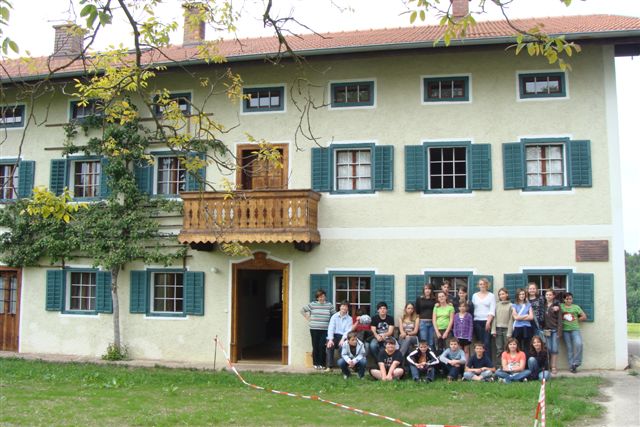
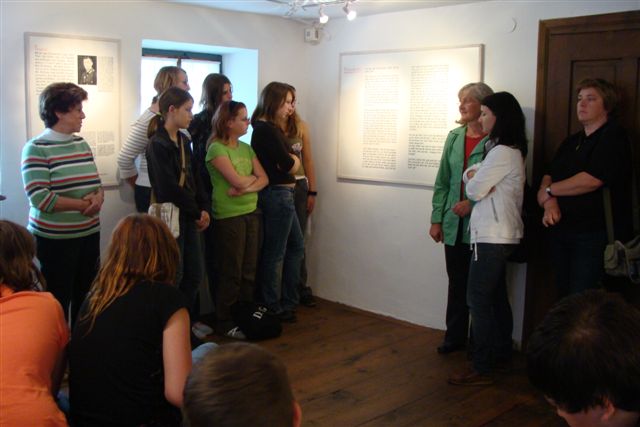

| M
U
S
E
U
M |  1993 - Franz Jägerstätter House, Sankt Radegund, Upper Austria (Austria). Sankt Radegund is a small village between Salzburg & Braunau am Inn. "Founded as a memorial to Franz Jägerstätter in his & his family’s former farmhouse. Most of the house remains in its original state. Displayed his personal belongings, his writings & other keepsakes. His wife Franziska, who was born in 1913 and is still alive, restored the original furnishings - including the table on which Jägerstätter wrote many of his letters & essays - and many personal items such as his wedding ring, rucksack, rosary & prayer book of the Third Order of St. Francis are on display. In addition there is a biographical exhibit with photos." 1993 - Franz Jägerstätter House, Sankt Radegund, Upper Austria (Austria). Sankt Radegund is a small village between Salzburg & Braunau am Inn. "Founded as a memorial to Franz Jägerstätter in his & his family’s former farmhouse. Most of the house remains in its original state. Displayed his personal belongings, his writings & other keepsakes. His wife Franziska, who was born in 1913 and is still alive, restored the original furnishings - including the table on which Jägerstätter wrote many of his letters & essays - and many personal items such as his wedding ring, rucksack, rosary & prayer book of the Third Order of St. Francis are on display. In addition there is a biographical exhibit with photos." 
|

 |   September 5, 1994 - Protestantendenkmal / Salzburger Monument of Reconciliation, Salzburger Park, Savannah, Georgia (USA). Between Lincoln Street & Abercorn Street ramps on Bay Street. "Dedicated by the country (predominantly Roman Catholic) to the descendants of the Georgia Salzburgers (Protestants) who were exiled in 1731 from Salzburg because of their religious beliefs. Green serpentine stone from the Hohe Tauern region of Austria. Human figures chiseled by Anton Thuswaldner depict the people forced from their homes in Salzburg. Inscribed, "Denied Their Religious Freedom They Were Forced to Leave Their Homeland." The first monument to be given to Savannah by a foreign government. September 5, 1994 - Protestantendenkmal / Salzburger Monument of Reconciliation, Salzburger Park, Savannah, Georgia (USA). Between Lincoln Street & Abercorn Street ramps on Bay Street. "Dedicated by the country (predominantly Roman Catholic) to the descendants of the Georgia Salzburgers (Protestants) who were exiled in 1731 from Salzburg because of their religious beliefs. Green serpentine stone from the Hohe Tauern region of Austria. Human figures chiseled by Anton Thuswaldner depict the people forced from their homes in Salzburg. Inscribed, "Denied Their Religious Freedom They Were Forced to Leave Their Homeland." The first monument to be given to Savannah by a foreign government. 
|

| S
T
O
N
E
S |   1997 to Date -
Stolpersteine / Stumbling Stones, Dachau & many other cities (Germany & Austria). "Artist Gunter Demnig [b.1947] has given this word a new meaning, that of a small, cobblestone-sized memorial for a single victim of Nazism. These memorials commemorate those deported and killed by the Nazis, mostly in Nazi concentration camps or extermination camps, including Jews, Sinti and Romani people (also called gypsies), members of the Resistance during World War II, homosexuals, Jehovah's Witnesses, Christians in opposition to the Nazis and the disabled. The list of cities that have stolpersteine now extends to several countries and hundreds of cities and towns." Demnig laid some 15,000 stones in over 345 towns by August 2008. 1997 to Date -
Stolpersteine / Stumbling Stones, Dachau & many other cities (Germany & Austria). "Artist Gunter Demnig [b.1947] has given this word a new meaning, that of a small, cobblestone-sized memorial for a single victim of Nazism. These memorials commemorate those deported and killed by the Nazis, mostly in Nazi concentration camps or extermination camps, including Jews, Sinti and Romani people (also called gypsies), members of the Resistance during World War II, homosexuals, Jehovah's Witnesses, Christians in opposition to the Nazis and the disabled. The list of cities that have stolpersteine now extends to several countries and hundreds of cities and towns." Demnig laid some 15,000 stones in over 345 towns by August 2008. | A
R
T
I
C
L
E | See "Do Tread on Me,"
an article about stolpersteine by Ingrid Scheffer, published by the Goethe-Institut.
|


| P
L
A
Q
U
E |  July 4, 1997 - Gedenktafel für Franz Jägerstätter / Commemorative plaque for Franz Jägerstätter, Witzlebenstraße 4-5, Reichskriegsgericht, Berlin-Charlottenburg (Germany). At the former military court. English text: "In this building on July 6, 1943, the Austrian farmer Franz Jägerstätter (1907-1943) was sentenced to death by the Supreme Military Court of the Third Reich on grounds of his conscientious objection to military service. In commemoration of Franz Jägerstätter and all those who for like reasons were made victims of military courts."
Franz Jägerstätter [1907-1943] was an Austrian conscientious objector sentenced to death (at this place) and executed by Nazi Germany during World War II. He was beatified by the Roman Catholic Church on October 26, 2007, in Linz (Austria). July 4, 1997 - Gedenktafel für Franz Jägerstätter / Commemorative plaque for Franz Jägerstätter, Witzlebenstraße 4-5, Reichskriegsgericht, Berlin-Charlottenburg (Germany). At the former military court. English text: "In this building on July 6, 1943, the Austrian farmer Franz Jägerstätter (1907-1943) was sentenced to death by the Supreme Military Court of the Third Reich on grounds of his conscientious objection to military service. In commemoration of Franz Jägerstätter and all those who for like reasons were made victims of military courts."
Franz Jägerstätter [1907-1943] was an Austrian conscientious objector sentenced to death (at this place) and executed by Nazi Germany during World War II. He was beatified by the Roman Catholic Church on October 26, 2007, in Linz (Austria).  
|

|  Date? - "Pax-Mundi-Denkmal / World Peace Monument," Stoob, Bergenland (Austria). Built by graduating class of State College of Ceramics & Furnaces. Five pillars apparently representing Australia, Europe, Africa, America & Asia. Date? - "Pax-Mundi-Denkmal / World Peace Monument," Stoob, Bergenland (Austria). Built by graduating class of State College of Ceramics & Furnaces. Five pillars apparently representing Australia, Europe, Africa, America & Asia.
|
  
 |  July 6-17, 2000 - Peace Bell, 1st Choir Olympics, Linz (Austria). "Go to the “Hauptplatz” in Linz (picture!) and find house no. 33. There’s a small entrance that leads you to a backyard. If you enter you will see a very special bell. It’s the original bell of the first-ever World Choir Games (WCG). In 2000 they were held in Linz for the first time, former known as the “Choir Olympics”. At that time its chime had opened the world’s first “Choir Olympics” and at the closing, after the Prizegiving ceremony, it has officially closed the first WCG. Our bell has its place of honor now, very close to the Hauptplatz" /// "The young history of the Choir Olympics begins with a drum-roll in the Upper Austrian provincial capital of Linz: For the first time in the history of the international choral movement, so many choirs from numerous nations come together to participate in a universal choir competition and at the same time celebrate a great festival of choral music. The Choir Olympics are born and are from now on firmly established in the diaries of many choirs from all over the world.
Patron: Dr. Thomas Klestil, Federal President of the Republic of Austria. July 6-17, 2000 - Peace Bell, 1st Choir Olympics, Linz (Austria). "Go to the “Hauptplatz” in Linz (picture!) and find house no. 33. There’s a small entrance that leads you to a backyard. If you enter you will see a very special bell. It’s the original bell of the first-ever World Choir Games (WCG). In 2000 they were held in Linz for the first time, former known as the “Choir Olympics”. At that time its chime had opened the world’s first “Choir Olympics” and at the closing, after the Prizegiving ceremony, it has officially closed the first WCG. Our bell has its place of honor now, very close to the Hauptplatz" /// "The young history of the Choir Olympics begins with a drum-roll in the Upper Austrian provincial capital of Linz: For the first time in the history of the international choral movement, so many choirs from numerous nations come together to participate in a universal choir competition and at the same time celebrate a great festival of choral music. The Choir Olympics are born and are from now on firmly established in the diaries of many choirs from all over the world.
Patron: Dr. Thomas Klestil, Federal President of the Republic of Austria.
|


|  2003 -
Friedensmauer / Peace Wall, Moosdorf, Braunau am Inn (Austria). "With the appointment to the Peace Community in 2003 [sic], Moosdorf committed itself to supporting all peace activities in the community, both ideally & financially. This peace consciousness has an external sign - peace monument & peace wall. Every citizen as well as visitor can form & shape his own peace brick. It is then [fired] & inserted into the wall. Thus, the monument continues to grow, it already consists of more than 4,000 peace bricks. ///
The Moosdorfer Peace Dialogue is an association that strives for peace at home & around the world. Our association currently comprises about 50 members & was founded in 2003. We see ourselves as a non-partisan, independent, open & accessible platform, which places peace efforts at the forefront. A core group of about 10 people meet[s] once a month to discuss planned actions, ongoing projects & peace talks or to critically question the current world events. [Google translation]" One of 15 peace monuments found in July 2017 by Googling "Friedensdenkmal" or "Friedensmahnmal." 2003 -
Friedensmauer / Peace Wall, Moosdorf, Braunau am Inn (Austria). "With the appointment to the Peace Community in 2003 [sic], Moosdorf committed itself to supporting all peace activities in the community, both ideally & financially. This peace consciousness has an external sign - peace monument & peace wall. Every citizen as well as visitor can form & shape his own peace brick. It is then [fired] & inserted into the wall. Thus, the monument continues to grow, it already consists of more than 4,000 peace bricks. ///
The Moosdorfer Peace Dialogue is an association that strives for peace at home & around the world. Our association currently comprises about 50 members & was founded in 2003. We see ourselves as a non-partisan, independent, open & accessible platform, which places peace efforts at the forefront. A core group of about 10 people meet[s] once a month to discuss planned actions, ongoing projects & peace talks or to critically question the current world events. [Google translation]" One of 15 peace monuments found in July 2017 by Googling "Friedensdenkmal" or "Friedensmahnmal."
|


|  Date? - Friedenskreuz/Peace Cross, on the Oberkaibling [Mountain], Pettenbach, Oberösterreich (Austria). "From the branch church of Heiligenleithen, south of Pettenbach, the path leads to the Friedenskreuz/Peace Cross on the Oberkaibling [Mountain], from where you have a beautiful view of the Upper Austrian Pre-Alps & the picturesque Alpine valley. One of 15 peace monuments found in July 2017 by Googling "Friedensdenkmal" or "Friedensmahnmal."
/// Image shows "50 Jahre Friedenskreuz am Oberkaibling." Date? - Friedenskreuz/Peace Cross, on the Oberkaibling [Mountain], Pettenbach, Oberösterreich (Austria). "From the branch church of Heiligenleithen, south of Pettenbach, the path leads to the Friedenskreuz/Peace Cross on the Oberkaibling [Mountain], from where you have a beautiful view of the Upper Austrian Pre-Alps & the picturesque Alpine valley. One of 15 peace monuments found in July 2017 by Googling "Friedensdenkmal" or "Friedensmahnmal."
/// Image shows "50 Jahre Friedenskreuz am Oberkaibling."
|


|  Date? - Landeplatz des Friedens, Kirchenplatz/Church Square, Peuerbach, Oberösterreich (Austria). Herbert Egger, 2008; Stelenprofile stellen die Friedenstaube dar / Landing place of the
Peace, Herbert Egger, 2008; Steles provide the
Peace doves. One of 15 peace monuments found in July 2017 by Googling "Friedensdenkmal" or "Friedensmahnmal." Date? - Landeplatz des Friedens, Kirchenplatz/Church Square, Peuerbach, Oberösterreich (Austria). Herbert Egger, 2008; Stelenprofile stellen die Friedenstaube dar / Landing place of the
Peace, Herbert Egger, 2008; Steles provide the
Peace doves. One of 15 peace monuments found in July 2017 by Googling "Friedensdenkmal" or "Friedensmahnmal."
|

| P
A
R
K |  August 8, 2006 -
Franz Jägerstätter Park, Braunau am Inn, Upper Austria (Austria). Franz Jägerstätter [1907-1943] was an Austrian conscientious objector sentenced to death and executed by Nazi Germany during World War II. He was beatified by the Roman Catholic Church on October 26, 2007, in Linz (Austria). Park identified by Gerard Lössbroek (Pax Christi) who attended the opening ceremony. August 8, 2006 -
Franz Jägerstätter Park, Braunau am Inn, Upper Austria (Austria). Franz Jägerstätter [1907-1943] was an Austrian conscientious objector sentenced to death and executed by Nazi Germany during World War II. He was beatified by the Roman Catholic Church on October 26, 2007, in Linz (Austria). Park identified by Gerard Lössbroek (Pax Christi) who attended the opening ceremony. 
|



| M E M O R I A L
 October 26, 2007 - Neuer Dom / New Cathedral, Linz (Austria). Franz Jägerstätter [1907-1943] is beatified by the Roman Catholic Church in a ceremony held by Cardinal José Saraiva Martins. His feast day is the day of his christening, May 21. He is the patron of Conscientious Objectors. Right image shows Gedenkstätte für den sel. Franz Jägerstätter / Memorial for the Blessed Franz Jägerstätter. October 26, 2007 - Neuer Dom / New Cathedral, Linz (Austria). Franz Jägerstätter [1907-1943] is beatified by the Roman Catholic Church in a ceremony held by Cardinal José Saraiva Martins. His feast day is the day of his christening, May 21. He is the patron of Conscientious Objectors. Right image shows Gedenkstätte für den sel. Franz Jägerstätter / Memorial for the Blessed Franz Jägerstätter.
|
  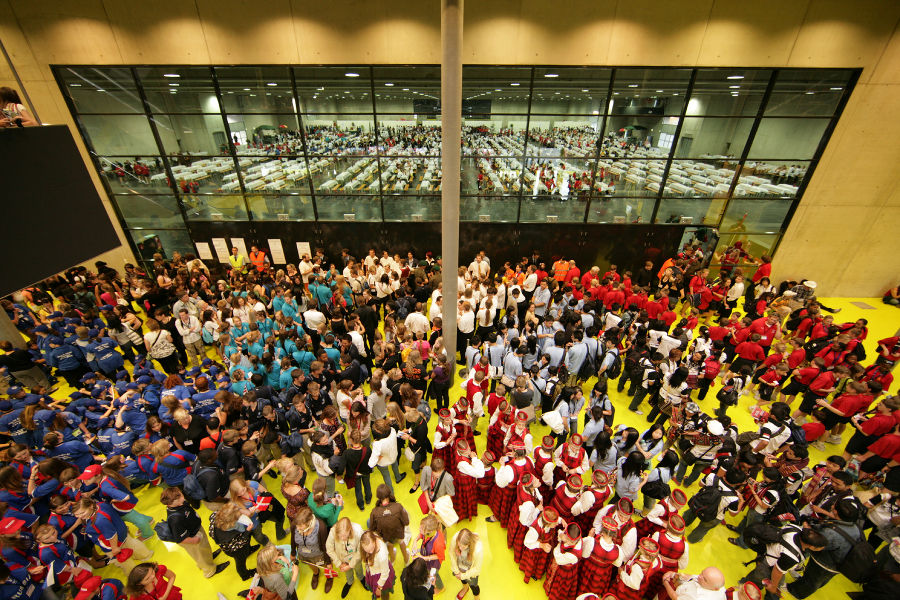 
 |  July 9-19, 2008 - Peace Bell, 5th World Choir Games (WCG), Graz (Austria). "The biggest and most successful choir competition of the world found its continuation in Austria. Graz, capital city of the province of Styria, is at the crossroads between different European cultures from the east and west, north and south. The unique old city center is one of UNESCO's world cultural heritage sites. In the year 2003, Graz was the spectacular cultural capital of Europe and in 2008 it was the world's capital of choral singing.
Patron: Dr. Heinz Fischer, Federal President of the Republic of Austria. July 9-19, 2008 - Peace Bell, 5th World Choir Games (WCG), Graz (Austria). "The biggest and most successful choir competition of the world found its continuation in Austria. Graz, capital city of the province of Styria, is at the crossroads between different European cultures from the east and west, north and south. The unique old city center is one of UNESCO's world cultural heritage sites. In the year 2003, Graz was the spectacular cultural capital of Europe and in 2008 it was the world's capital of choral singing.
Patron: Dr. Heinz Fischer, Federal President of the Republic of Austria.
|

| S
T
U
P
A |  2012? - World Peace Monument, Gfoehl (Austria). "VIENNA (AFP): A small Austrian town will carry out a public survey on a planned Buddhist stupa billed as Europe's biggest 'world peace monument' after some locals expressed unease, the mayor said on Wednesday [Dec. 14, 2011]. //
The town council in Gfoehl in northern Austria decided on late Tuesday to carry out a public consultation in February on whether they are in favour of the stupa, set to be 37m high and 25m in diametre. //
'We plan to listen to what people have to say and then the council will decide,' Mayor Karl Simlinger told AFP, saying 21 members of the 23-member body supported the project. //
'There have been a few letters in favour and against, but on the whole people are in favour... This is something that would be good for tourism and the economy in Gfoehl.' Next to the monument in the eastern outskirts of the town will be a 600 sq m building with accommodation for monks and nuns as well as meditation rooms, according to planners." /// Image published with story but appears to be illustrative only. 2012? - World Peace Monument, Gfoehl (Austria). "VIENNA (AFP): A small Austrian town will carry out a public survey on a planned Buddhist stupa billed as Europe's biggest 'world peace monument' after some locals expressed unease, the mayor said on Wednesday [Dec. 14, 2011]. //
The town council in Gfoehl in northern Austria decided on late Tuesday to carry out a public consultation in February on whether they are in favour of the stupa, set to be 37m high and 25m in diametre. //
'We plan to listen to what people have to say and then the council will decide,' Mayor Karl Simlinger told AFP, saying 21 members of the 23-member body supported the project. //
'There have been a few letters in favour and against, but on the whole people are in favour... This is something that would be good for tourism and the economy in Gfoehl.' Next to the monument in the eastern outskirts of the town will be a 600 sq m building with accommodation for monks and nuns as well as meditation rooms, according to planners." /// Image published with story but appears to be illustrative only.
|

|  October 24, 2014 - Deserteursdenkmal / Deserters Monument, Vienna (Austria). Opposite Austria's federal chancellery building. X-shaped monument with "all alone" etched multiple times across its top. "It follows a decision by Austria's parliament in 2009 to rehabilitate thousands of soldiers criminalised by the Nazis for desertion." Information courtesy of Gerard Lössbroek. October 24, 2014 - Deserteursdenkmal / Deserters Monument, Vienna (Austria). Opposite Austria's federal chancellery building. X-shaped monument with "all alone" etched multiple times across its top. "It follows a decision by Austria's parliament in 2009 to rehabilitate thousands of soldiers criminalised by the Nazis for desertion." Information courtesy of Gerard Lössbroek. 
|

|  October 26, 2014 - Friedensglocke / Peace Bell, Parish Church of Linz, Linz (Austria). Replaces bell confiscated by the Nazis &
melted down for war purposes. 2,200 kg with peace dove on reverse side. Cast at Bachert Bell Foundry in Karlsruhe (Germany). Dedicated to the Blessed Franz
Jagerstatter [1907-1943] & his wife Franziska. Information courtesy of Gerard Lössbroek. October 26, 2014 - Friedensglocke / Peace Bell, Parish Church of Linz, Linz (Austria). Replaces bell confiscated by the Nazis &
melted down for war purposes. 2,200 kg with peace dove on reverse side. Cast at Bachert Bell Foundry in Karlsruhe (Germany). Dedicated to the Blessed Franz
Jagerstatter [1907-1943] & his wife Franziska. Information courtesy of Gerard Lössbroek.
|
 |  October 2, 2017 -
Mahnmal fuer aktive Gewaltfreiheit /
Monument for Active Nonviolence, Nibelungenbrücke, Linz (Austria). "A platform in a circle, with a diameter of 3 metres, onto which you can step. On the platform, facing each other, are a cylindrical & a cubic 'pedestal' (on each of which a person can sit) which represent the different positions of the two parties in dialogue. Claimed to be 'the first in Europe.' The work is by Karl-Heinz Klopf, a local artist." October 2 is International Day of Nonviolence & Gandhi's birthday. Linz is officially a city of peace since 1986.
/// Information courtesy of Christian Bartolf & Peter van den Dungen. /// Compare 1994 "Peace Thrones" in Bluffton, Ohio (USA), in image at right. October 2, 2017 -
Mahnmal fuer aktive Gewaltfreiheit /
Monument for Active Nonviolence, Nibelungenbrücke, Linz (Austria). "A platform in a circle, with a diameter of 3 metres, onto which you can step. On the platform, facing each other, are a cylindrical & a cubic 'pedestal' (on each of which a person can sit) which represent the different positions of the two parties in dialogue. Claimed to be 'the first in Europe.' The work is by Karl-Heinz Klopf, a local artist." October 2 is International Day of Nonviolence & Gandhi's birthday. Linz is officially a city of peace since 1986.
/// Information courtesy of Christian Bartolf & Peter van den Dungen. /// Compare 1994 "Peace Thrones" in Bluffton, Ohio (USA), in image at right.
| 
|
(3) Note about mahnmal & denkmal
"Before WW-II there were no warning monuments [mahnmal] in Germany. Instead there were war memorials [denkmal], to fallen soldiers dying, like marble Christs, for the fatherland. The bonds of national community were strengthened through therir sacrifice. War, in Great War monuments, is a mystical experience, a Calvary of valor, sacrifice, and regeneration. Great Gothic memorial fortresses were built in the German Reich to pluck honor from defeat. Nothing like this emerged after WW-II. Insted, the Germans built monuments not to glorify but to warn; Denkmal became Mahnmal. /// Like a monumental rosary, spread mostly over western Germany, the monuments testify to a fretting overmall Austrian town will carry out a public survey on a planned Buddhist stupa billed as Europe's biggest 'world peace monument' after some locals expressed unease, the mayor said on Wednesday [Dec. 14, 2011]. //
The town council in Gfoehl in northern Austria decided on late Tuesday to carry out a public consultation in February on whether they are in favour of the stupa, set to be 37m high and 25m in diametre. //
'We plan to listen to what people have to say and then the council will decide,' Mayor Karl Simlinger told AFP, saying 21 members of the 23-member body supported the project. //
'There have been a few letters in favour and against, but on the whole people are in favour... This is something that would be good for tourism and the economy in Gfoehl.' Next to the monument in the eastern outskirts of the town will be a 600 sq m building with accommodation for monks and nuns as well as meditation rooms, according to planners." /// Image published with story but appears to be illustrative only.





1181 - "Noah Receiving the Dove," Augustinian Monastery, Vindobona, near Vienna (Austria). Part of panel #15 of 17 tripartite panels known as the Altar of Verdun. Created during the short interval between the 2nd and 3rd crusades.

1819 - "Congress of Vienna," Musee du Louvre, Paris (France). By Jean-Baptiste Isabey [1767-1855]. "The Congress of Vienna was a conference of ambassadors of European states chaired by the Austrian statesman Klemens Wenzel von Metternich, and held in Vienna from September 1814 to June 1815."


1927 - Esperanto Museum, Österreichische Nationalbibliothek / Austrian National Library, Palais Mollard, 1 Herrengasse 9, Vienna (Austria). "Biggest collection of artificial languages in the world and a linguistic research library for language planning."

1951 - "The Pummerin," North Tower, Stephansdom / St. Stephen's Cathedral, Wien/Vienna (Austria). "By the Turks guns originating from material and its casting in the early days of the Second Republic, it is also a symbol of peace, freedom and the country as a gift from the province of Upper Austria for the St. Stephen's Cathedral was destroyed in World War II as a symbol of the reconstruction [Google translation]." Called "The Voice of Austria." At 21,383 kg, the third largest bell in Western & Central Europe, after St. Petersglocke in Cologne Cathedral (24.000 kg) and Maria Dolens (qv) in Rovereto, Italy (23.000 kg).


1953 - Bust of Heinrich Lammasch, The Arkadenhof, University of Vienna, Vienna (Austria). Heinrich Lammasch [1853-1920] was a great Austrian peacemaker: Professor of Penal Law & International Law, & scholar/publicist, as well as active as diplomat (& the last prime minister of imperial Austria). He had strong links with the peace movement. As "a member of the Hague Arbitration Tribunal,... he arranged the Newfoundland dispute between Great Britain & the USA [in 1910]." Information courtesy of Peter van den Dungen.

1956 - the Globe Museum, Österreichische Nationalbibliothek / Austrian National Library, Palais Mollard, 1 Herrengasse 9, Vienna (Austria). Collection of more than 400 globes, 240 of which are on display, including early modern globes by Mercator, Blaeu & Coronelli. Reopened in larger space on December 1, 2005. Click here for description of a visit in December 2001.

Date? - Henri Dunant Denkmal / Henri Dunant Monument, H.R. Pippal, Karl-Seitz-Hof, Dunantgasse, Floridsdorf, Vienna (Austria). Henry Dunant [1828-1910] founded the Red Cross and received the first Nobel Peace Prize in 1901.

August 23, 1979 - Vienna International Centre (VIC), UN Office at Vienna (UNOV), Vienna (Austria). Includes headquarters of the International Atomic Energy Agency (IAEA) and the UN Industrial Development Organization (UNIDO), respectively in Vienna since 1957 and 1967.


1983 - Replica of the Code of Hammurabi," International Atomic Energy Agency (IAEA), Vienna International Centre (VIC), Vienna (Austria). "The Code of Law Stele of Hammurabi is a well-preserved Babylonian law code, dating to ca. 1700 B.C. The original stele today is on display in the Louvre Museum in Paris (France). The replica, a gypsum cast, was donated to the IAEA by Iraq in 1983 on the occasion of the 25th Anniversary of the Agency. The sixth Babylonian king, Hammurabi [1792-1750 BC], enacted the code, and partial copies exist on a human-sized stone stele and on various clay tablets. The Code consists of 282 laws, with punishments like 'an eye for an eye, a tooth for a tooth,' also known as lex talionis. The Code is inscribed in the Akkadian language, using cuneiform script carved into the stele. This Law was written before the Mosaic Code and was one of the first written laws in the world. The Code of Hammurabi was written on a stele, a large stone monument, and placed in a public place so that all could see it. The stele was later plundered by the Elamites in the 12th century BC and removed to their capital, Susa, Elam (now Khuzestan, Iran); it was rediscovered there in 1901 by the Egyptologist Gustave Jéquier. "




November 24, 1988 - Mahnmal gegen Krieg und Faschismus / Monument Against War & Fascism, Albertinaplatz, Vienna (Austria). By Austrian artist Alfred Hrdlicka [1928-2009]. This square is the site of a massacre in 1945 when an Allied bomb killed an unknown number of civilians taking shelter in the basement of a building. "Immensely controversial. No distinction among different groups who died in WW-II. Lead directly to the campaign for the 2000 Judenplatz memorial [qv]." See Winstone (2010), page 135.

1994 - Schulschiff / Training Ship, Bundesgymnasium und Bundesrealgymnasium 'Bertha von Suttner' (GRG 21), anchored in the Danube River, Vienna (Austria). "Two boats with 36 classrooms and administrative offices. The gym is located on a third float." Named for Baroness Bertha von Suttner [1843-1914] who received the Nobel Peace Prize in 1905. The Donauturm / Danube Tower & Vienna International City (VIC) are visible in the backround of the image.

1994 - Sculpture "Swords into Ploughshares," International Atomic Energy Agency (IAEA), Vienna International Centre (VIC), Vienna (Austria). "This sculpture, made out of non-nuclear material from a dismantled nuclear device, symbolizes the commitment to the non-proliferation of nuclear weapons. It was donated to the IAEA by the Republic of South Africa in 1994. 'And they shall beat their swords into ploughshares, and their spears into pruning hooks. Nation shall not lift up sword against nation, neither shall they learn war any more.' (Quotation from Isaiah 2:4) Although this is the smallest sculpture at the UN Vienna, it is by no means the least important."



1995 - United Nations Peace Bell, Vienna International Centre (VIC), Vienna (Austria). Cast in Japan.



October 25, 2000 - Mahnmal für die 65.000 ermordeten österreichischen Juden und Jüdinnen der Shoah / Memorial to the Victims of the Holocaust, Judenplatz, Vienna (Austria). Designed by the British artist Rachel Whiteread." The central memorial for the Austrian victims of the Holocaust. Also known as the Nameless Library. "Cast concrete, with the walls made up of rows of books, with the pages, rather than the spines, turned outward; this can be regarded as a comment on Jews as a 'people of the book' & the Nazi book burnings. On one of the walls is the negative cast of double-doors." See Winstone (2010), pages 132-3.
2002 - Garden of Peace, Vienna (Austria). "Oil on canvas by Werner Horvath. Depicts Hannah Arendt [1906-1975], Mahatma Gandhi [1869-1948], Bertha von Suttner [1843-1914] & Immanuel Kant [1724-1804]." Bertha von Suttner [1843-1914] was an Austrian novelist, radical (i.e. organizational) pacifist, and the first woman to receive the Nobel Peace Prize (in 1905).





2006-2007 - John Lennon - Peace Altar, Vienna (Austria). Oil on wood, 100 x 261cm, by Werner Horvath. Click here
![]()
September 9, 2009 - Hiroshima Peace Monument, Ottakring District, Vienna (Austria). "Some 100 people from Japan and Austria attended the unveiling Wednesday of a stone peace monument featuring a flagstone that was exposed to radiation in the 1945 U.S. atomic bombing of Hiroshima. The Vienna monument is linked with a children's peace monument in Hiroshima's Peace Memorial Park that is dedicated to Sadako Sasaki [1943-1955], a girl exposed to atomic radiation at the age of 2 & who died at age 12 from a radiation-caused illness. Austrian children's writer Karl Bruckner [1906-1982] authored "Sadako will leben" ("The Day of the Bomb") in 1961 with Sasaki as its heroine. The book has been translated into more than 20 languages. Citizens' groups in Hiroshima & Vienna decided to build the stone monument in the Austrian capital's Ottakring district, Bruckner's home area, to mark the 140th anniversary of the establishment of diplomatic ties between Japan & Austria. The Hiroshima Municipal Government contributed the flagstone from Hiroshima's old City Hall. It measures 180 cm high & weighs about 800 kg. It is inscribed with the words "world peace" in Japanese & German."



May 25, 2011 - Memorial plaque for Alfred Hermann Fried, Widerhofergasse 5, 9th district, Vienna (Austria). Fried [1864-1921] was an Austrian Jewish pacifist, publicist, journalist & co-founder of the German peace movement. Shared Nobel prize with Tobias Asser) [1838-1913]. The plaque is "his first Memorial in Vienna... More than 200 people and took part in the ceremony. Klaus Maria Brandauer unveiled the commemorative plaque at the fountain Hevenu Shalom choir sang." Google translation: "... Europe is not the affair of an individual State... / ORGANIZE THE WORLD! / ALREFD HERMANN FRIED / * November 11, 1864 in Vienna. + 4 May 1921 in same place. / Lived in this house when he was awarded the Nobel Peace Prize in 1911. / He is considered the founder of peace research. / This marks the 100th Anniversary of the Nobel Peace Prize ceremony." /// Info & image courtesy of Peter van den Dungen.
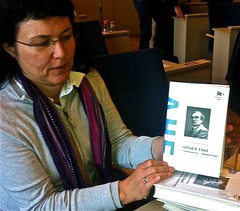

September 2011 - "Alfred H. Fried: Friedensaktivist - Nobelpreisträger / Alfred H. Fried: Peace activist - Nobel laureate" by Petra Schoenemann-Behrens. Biography of Alfred H. Fried [1864-1921]. Edited by Andreas Hermann Landl, the peace journalist from Vienna. Contains epilogue by Peter van den Dungen. Photo of Schoenemann-Behrens by Andreas Landl.
October 28-29, 2011 - "Symposium zu Friedensaktivist Fried / Sympossium on Peaceactivist Fried," Town Hall, Friedrich-Ebert-Strasse, Potsdam (Germany). "Who knows the German Peace Prize? In Potsdam, Bertha von Suttner is still present, less their long-time employee and later winner Alfred Hermann Fried. The Vienna-born peace activist, founded in 1892 with her ??along the German Peace Society and 'The peace waiting.' The monthly magazine quickly developed into an important organ of the peace movement. 100 years after the [Nobel] award ceremony, organized by the International Peace Bureau (IPB) in cooperation with the Working Group Historical Peace Research (AKHF), Bertha von Suttner Foundation of the German Peace Society & the United War Resisters (DFG-VK) a two-day symposium on 'Organize the world! The Nobel Peace Prize laureate Alfred Hermann Fried (1864-1921): Life, work and lasting impact.' [Google translation]" Click here for final symposium program in German & English (PDF file).
December 1, 2011 - "A second seminar on Fried is due to be held in the Austrian Parliament, Vienna (Austria), on Dec 1st, 2011." /// "There will be a panel discussion, with Jalka, Peter van den Dungen & Walter Goehring, on why Nobel peace laureates are so quickly forgotten, on the occasion of the Fried year."
December 1, 2011 - "Wiener Friedenspfade / Vienna peace paths," Vienna (Austria). Suggested by Peter van den Dungen & developed by Suzanne Jalka, the "head" of the Quakers in German-speaking Europe. Image shows Jalka & the trail guide, "Frieden entdecken in Wien / Discovering peace in Vienna," 200 pages (with separate map in pocket inside the back cover), written by Jalka & two co-authors, to be launched December 1 at the Austrian Parliament. "Jalka lives in Cak (Hungary) & works again in her native Vienna (Austria) as a conflict consultant & author." /// The trail undoubtedly includes the Congress of Vienna in 1814-15, Bertha von Suttner [1843-1914], Alfred Fried [1864-1921], and the inauguration of the Universal Peace Federation (UPF) in 2005. /// Information courtesy of Peter van den Dungen. Photo from Andreas Landl, the peace journalist from Vienna.
July 27, 2012 - Plaque commemorating Count Richard Graf Coudenhove-Kalergi, Heiligen Kreuzer-Hof, Vienna (Austria). Google translation: "In this house, in the Pralatur Heiligenkreuzerhof lived the founder of the PanEuropean Union and spiritual father of the European agreement, RICHARD GRAF COUDENHOVE-KALERGI. From here, he fled in the night of 11 to 12 March 1938 the occupation forces of Nazi Germany. Austrian Pan European Association. To mark the 40 anniversary of his death on 27 July 2012." /// "Coudenhove-Kalergi, born November 16, 1894, in Tokyo (Japan); died July 27, 1972 in Schruns (Austria), was a Japanese Austrian writer, politician & founder of the Paneuropa movement." Information courtesy of Peter van den Dungen.

1807 - Peace of Pressburg Column, Klagenfurt am Wörthersee, Carinthia (Austria). Google translation: "The slim and about 20 meters high column of Salzburg marble was created in 1807 by the South Tyrolean master sculptor Johann Probst. You should remember the Peace of Pressburg between Austria and Napoleon (1805), and was donated by Cardinal Franz Xaver Altgraf of Salm-Reifferscheidt Herb home. Cardinal Salm, Prince-Bishop of Gurk, was during the first ascent of the highest mountain in Austria, the Grossglockner (27 July 1800), the process and gained high earnings during the occupation by the French in Klagenfurt. The obelisk bears on its head as a symbolic peace sign cross and palm trees...."

May 3, 1975 - Mauthausen-Gusen Concentration Camp, Mauthausen & Gusen (Austria). Center of a group of SS slave labor camps. Original inmates were largely Germans who had resisted the Nazi regime, notable communists, socialists, and religious dissenters. Thirty years after liberation Chancellor Bruno Kreisky officially opened the Mauthausen Museum. Many of the sub-camps near Gusen are now covered by residential areas built after the war. In February 2009 the memorial was vandalized by persons unknown, who defaced a section of the wall with anti-Islamic graffiti. Right image shows a 1978 East German postage stamp.




1977 - Peace Monument, Sankt Ulrich (Austria). "Austria's First Peace Monument. On the occasion of St. Ulricher Kulturtage 1977 the first peace monument in Austria was built in Ortisei. From 70 countries of the world, building blocks were sent. The sculptor Prof. Alois Dorn shaped the building blocks to a four-and-a-half-meter-high, narrow column. All stones were poured into them, so that the semicircular inner wall shows the face of the stones. Furthermore a bronze world globe with a peace dove was introduced [Google translation]." One of 15 peace monuments found in July 2017 by Googling "Friedensdenkmal" or "Friedensmahnmal." GLOBE DOVE


Date? - Ereignisdenkmal, Friedensdenkmal d. Siedlung Friedensstadt Denkmalschutz-AT.svg Austria Bundesadler.svg This media shows the protected monument with the number 75669 in Austria. One of 15 peace monuments found in July 2017 by Googling "Friedensdenkmal" or "Friedensmahnmal."


Date? - Friedenskreuz/Peace Cross, on the Oberkaibling [Mountain], Pettenbach, Oberösterreich (Austria). "From the branch church of Heiligenleithen, south of Pettenbach, the path leads to the Friedenskreuz/Peace Cross on the Oberkaibling [Mountain], from where you have a beautiful view of the Upper Austrian Pre-Alps & the picturesque Alpine valley. One of 15 peace monuments found in July 2017 by Googling "Friedensdenkmal" or "Friedensmahnmal." /// Image shows "50 Jahre Friedenskreuz am Oberkaibling."


Date? - Landeplatz des Friedens, Kirchenplatz/Church Square, Peuerbach, Oberösterreich (Austria). Herbert Egger, 2008; Stelenprofile stellen die Friedenstaube dar / Landing place of the Peace, Herbert Egger, 2008; Steles provide the Peace doves. One of 15 peace monuments found in July 2017 by Googling "Friedensdenkmal" or "Friedensmahnmal."


Date? - Denkmal für den Weltfrieden / Monument for World Peace, Platz des Friedens, on Achalm [Mountain], Reutlingen, Baden-Württemberg (Germany). Ein Denkmal für den Weltfrieden auf der Achalm. "Peace monument on the square of peace on the Achalm. A monument to world peace on the Achalm." /// "In the Name of Peace. 'The flame of peace / A symbol of global peace / In memory of our mission / To work for peace / In thought, words, and deeds." /// "The Flame of Peace / Flamme des Friedens is an award granted by the Austrian non-profit organization Vereins zur Förderung des Friedens / Association for the Promotion of Peace, which promotes world peace. The flame is represented by a wood carving mounted on a stone base. The organization gives out awards to prominent people, peace activists & organizations for their activity in promoting peace. /// Her Imperial Royal Highness Princess Herta Margarete of Hapsburg-Lorraine, Archduke of Austria, Princess of Tuscany, Princess of Hungary, Princess of Bohemia, Princess of Croatia, President of the Flame of Peace [Google translation]." /// "Sample Monuments" erected at Schloss Wilhelminenberg in Vienna (Austria), March 2009; Sana'a (Yemen), September 2009; Mitterdorf (Austria), March 14, 2012; and Ernstbrunn (Austria), May 26, 2012.
One of 15 peace monuments found in July 2017 by Googling "Friedensdenkmal" or "Friedensmahnmal." FLAMES


1987 - Statue of Franz Jägerstätter, Saint Malachy Church, North Philadelphia, Pennsylvania (USA). "Why, given the awe-inspiring calendar of saints, is St. Malachy so taken with a virtually unknown Austrian peasant from WW-II times? In God’s providence & with the generosity of Fr. Daniel Berrigan, we possess on a side altar a magnificent carved statue of [Franz] Jägerstätter. The artist, Bob McGovern [1933-2011], one of our fellow parishoners, carved the statue to honor Fr. Dan’s fifty years as a Jesuit in 1987. Fr. Berrigan has great devotion to Jägerstätter, but stripping down in his mid-eighties, donated the statue to St. Malachy as a place where the peace of Christ will be celebrated." Info courtesy of Gerard Lössbroek (Pax Christi International).





April 20, 1989 - Hitler's Birthplace, Salzburger Vorstadt, Braunau am Inn (Austria). The former Gasthof zum Pommer or Gasthof des Josef Pommer. Original address was Salzburger Vorstadt 219 when Adolf Hitler was born here at 6:30 p.m. on April 20, 1889, Easter Sunday. House is is unmarked, except for a large stone of Mauthausen granite which was placed on 100th anniversary of Hitler's birth. English translation: "For peace, freedom and democracy, never again Fascism, millions of dead admonish."


1989 - Postage stamp (Austria) honoring Alfred Hermann Fried [1864-1921] who received the Nobel Peace Prize in 1911.


1993 - Postage stamp (Austria). "For the 50th Anniversary of the resistance fighter Franz Jägerstätter" (Österrreichische Briefmarke zum 50. Todestag des Widerstandskämpfers Franz Jägerstätter).





About 1991 - Monuments celebrating the Pan-European Picnic, Sopron (Austria/Hungary). "The Pan-European Picnic / Paneuropäisches Picknick / páneurópai piknik was a peace demonstration held on the Austrian-Hungarian border near the town of Sopron on 19 August 1989, an important event during the Revolutions of 1989 that led to the fall of the Iron Curtain & the reunification of Germany... The place of the picnic is marked by a monument of Miklós Melocco [left image], by a bell presented from the city of Debrecen (Hungary) from where the idea of the Picnic emerged, a pagoda presented by the Association of the Japanese–Hungarian Friendship and by a wooden monument unveiled by the organisors [sic] in 1991. A large artwork made by Gabriela von Habsburg, a daughter of Otto von Habsburg, & symbolizing a Cross & a barbed wire [right image] can be found at the Cave Theatre of Fertorakos (Hungary), a few kilometres from the site. Hungarian President László Sólyom unveiled a white marble monument in memory of those who had risked their life to cross the Iron Curtain."



1993 - Franz Jägerstätter House, Sankt Radegund, Upper Austria (Austria). Sankt Radegund is a small village between Salzburg & Braunau am Inn. "Founded as a memorial to Franz Jägerstätter in his & his family’s former farmhouse. Most of the house remains in its original state. Displayed his personal belongings, his writings & other keepsakes. His wife Franziska, who was born in 1913 and is still alive, restored the original furnishings - including the table on which Jägerstätter wrote many of his letters & essays - and many personal items such as his wedding ring, rucksack, rosary & prayer book of the Third Order of St. Francis are on display. In addition there is a biographical exhibit with photos."




1993 - Erstes Osterreichisches Friedensmuseen / First Austrian Peace Museum, Heimatkreis Wolfsegg, Schulstrasse 18, Marktgemeinde Wolfsegg, Wolfsegg (Austria). "The Wolfsegg Peace Museum is designed & is currently used only for limited visits. Alternatively, the home office in the old elementary school that is dedicated to the times of our ancestors [may be] visited." [Google translation] Member of International Network of Museums for Peace (INMP).


September 5, 1994 - Protestantendenkmal / Salzburger Monument of Reconciliation, Salzburger Park, Savannah, Georgia (USA). Between Lincoln Street & Abercorn Street ramps on Bay Street. "Dedicated by the country (predominantly Roman Catholic) to the descendants of the Georgia Salzburgers (Protestants) who were exiled in 1731 from Salzburg because of their religious beliefs. Green serpentine stone from the Hohe Tauern region of Austria. Human figures chiseled by Anton Thuswaldner depict the people forced from their homes in Salzburg. Inscribed, "Denied Their Religious Freedom They Were Forced to Leave Their Homeland." The first monument to be given to Savannah by a foreign government.


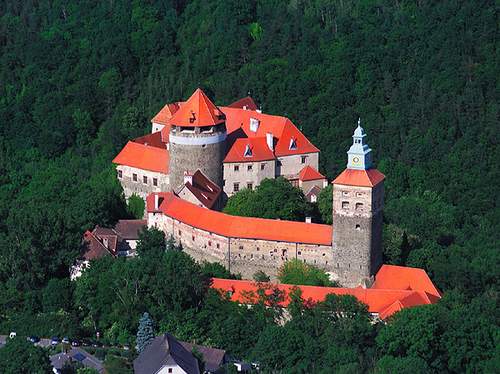

August 1995 - 2nd International Conference of Peace Museums, International Network of Peace Museums (INMP), at the European University Center for Peace Studies (EPU), Burg Schlaining, Rochusplatz 1, A-7461 Stadtschlaining, Bergenland (Austria). Hosted by Dr. Gerald Mader. In 2001 Burg Schlaining became the home of the Europäische Museum für den Frieden / European Museum for Peace (qv). Right image courtesy of Gerard Lössbroek.


1997 to Date - Stolpersteine / Stumbling Stones, Dachau & many other cities (Germany & Austria). "Artist Gunter Demnig [b.1947] has given this word a new meaning, that of a small, cobblestone-sized memorial for a single victim of Nazism. These memorials commemorate those deported and killed by the Nazis, mostly in Nazi concentration camps or extermination camps, including Jews, Sinti and Romani people (also called gypsies), members of the Resistance during World War II, homosexuals, Jehovah's Witnesses, Christians in opposition to the Nazis and the disabled. The list of cities that have stolpersteine now extends to several countries and hundreds of cities and towns." Demnig laid some 15,000 stones in over 345 towns by August 2008.


July 4, 1997 - Gedenktafel für Franz Jägerstätter / Commemorative plaque for Franz Jägerstätter, Witzlebenstraße 4-5, Reichskriegsgericht, Berlin-Charlottenburg (Germany). At the former military court. English text: "In this building on July 6, 1943, the Austrian farmer Franz Jägerstätter (1907-1943) was sentenced to death by the Supreme Military Court of the Third Reich on grounds of his conscientious objection to military service. In commemoration of Franz Jägerstätter and all those who for like reasons were made victims of military courts." Franz Jägerstätter [1907-1943] was an Austrian conscientious objector sentenced to death (at this place) and executed by Nazi Germany during World War II. He was beatified by the Roman Catholic Church on October 26, 2007, in Linz (Austria).




October 12, 1997 - Friedensglocke des Alpenraumes / Peace Bell of the Alpine Region , Hotel Habhof, Mösern bei Seefeld, Upper Inntal Valley (Austria). Commemorates the 25th anniversary of the ARGE ALP agreement signed in Mösern by eleven Alpine states to "seek joint solutions in the fields of culture & economy, agriculture & traffic." Rings every day at 5:00 pm. Cast at the Grassmayr Foundry in nearby Innsbruck. Second image shows spectacular view from the bell of the Inn River Valley.


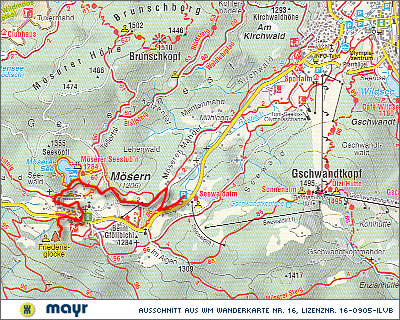
After 1997 - Fridensglocken-Wanderweg / Peace Bell Hiking Trail, Mösern bei Seefeld, Upper Inntal Valley (Austria). Mösern calls itself "Friedens Dorf" / "Peace Village" because of the 1972 treaty and the 1997 Friedensglocke des Alpenraumes / Peace Bell of the Alpine Region. The trail is designed to cover scenic spots, takes about 90 minutes to hike, and ends at the Peace Bell.

Date? - "Pax-Mundi-Denkmal / World Peace Monument," Stoob, Bergenland (Austria). Built by graduating class of State College of Ceramics & Furnaces. Five pillars apparently representing Australia, Europe, Africa, America & Asia.


July 6-17, 2000 - Peace Bell, 1st Choir Olympics, Linz (Austria). "Go to the “Hauptplatz” in Linz (picture!) and find house no. 33. There’s a small entrance that leads you to a backyard. If you enter you will see a very special bell. It’s the original bell of the first-ever World Choir Games (WCG). In 2000 they were held in Linz for the first time, former known as the “Choir Olympics”. At that time its chime had opened the world’s first “Choir Olympics” and at the closing, after the Prizegiving ceremony, it has officially closed the first WCG. Our bell has its place of honor now, very close to the Hauptplatz" /// "The young history of the Choir Olympics begins with a drum-roll in the Upper Austrian provincial capital of Linz: For the first time in the history of the international choral movement, so many choirs from numerous nations come together to participate in a universal choir competition and at the same time celebrate a great festival of choral music. The Choir Olympics are born and are from now on firmly established in the diaries of many choirs from all over the world. Patron: Dr. Thomas Klestil, Federal President of the Republic of Austria.



2001 - Europäische Museum für den Frieden / European Museum for Peace, Burg Schlaining, Rochusplatz 1, Stadtschlaining, Bergenland (Austria). "An offshoot of the Provincial Exhibition on 'War or Peace.'" Associated with the Österreichische Studienzentrum für Frieden und Konfliktlösung (ÖSFK) / Austrian Study Center for Peace & Conflict Resolution (ASPR). Member of International Network of Museums for Peace (INMP).


2003 - Friedensmauer / Peace Wall, Moosdorf, Braunau am Inn (Austria). "With the appointment to the Peace Community in 2003 [sic], Moosdorf committed itself to supporting all peace activities in the community, both ideally & financially. This peace consciousness has an external sign - peace monument & peace wall. Every citizen as well as visitor can form & shape his own peace brick. It is then [fired] & inserted into the wall. Thus, the monument continues to grow, it already consists of more than 4,000 peace bricks. /// The Moosdorfer Peace Dialogue is an association that strives for peace at home & around the world. Our association currently comprises about 50 members & was founded in 2003. We see ourselves as a non-partisan, independent, open & accessible platform, which places peace efforts at the forefront. A core group of about 10 people meet[s] once a month to discuss planned actions, ongoing projects & peace talks or to critically question the current world events. [Google translation]" One of 15 peace monuments found in July 2017 by Googling "Friedensdenkmal" or "Friedensmahnmal."


Date? - Friedenskreuz/Peace Cross, on the Oberkaibling [Mountain], Pettenbach, Oberösterreich (Austria). "From the branch church of Heiligenleithen, south of Pettenbach, the path leads to the Friedenskreuz/Peace Cross on the Oberkaibling [Mountain], from where you have a beautiful view of the Upper Austrian Pre-Alps & the picturesque Alpine valley. One of 15 peace monuments found in July 2017 by Googling "Friedensdenkmal" or "Friedensmahnmal." /// Image shows "50 Jahre Friedenskreuz am Oberkaibling."


Date? - Landeplatz des Friedens, Kirchenplatz/Church Square, Peuerbach, Oberösterreich (Austria). Herbert Egger, 2008; Stelenprofile stellen die Friedenstaube dar / Landing place of the Peace, Herbert Egger, 2008; Steles provide the Peace doves. One of 15 peace monuments found in July 2017 by Googling "Friedensdenkmal" or "Friedensmahnmal."

August 8, 2006 - Franz Jägerstätter Park, Braunau am Inn, Upper Austria (Austria). Franz Jägerstätter [1907-1943] was an Austrian conscientious objector sentenced to death and executed by Nazi Germany during World War II. He was beatified by the Roman Catholic Church on October 26, 2007, in Linz (Austria). Park identified by Gerard Lössbroek (Pax Christi) who attended the opening ceremony.




October 26, 2007 - Neuer Dom / New Cathedral, Linz (Austria). Franz Jägerstätter [1907-1943] is beatified by the Roman Catholic Church in a ceremony held by Cardinal José Saraiva Martins. His feast day is the day of his christening, May 21. He is the patron of Conscientious Objectors. Right image shows Gedenkstätte für den sel. Franz Jägerstätter / Memorial for the Blessed Franz Jägerstätter.



July 9-19, 2008 - Peace Bell, 5th World Choir Games (WCG), Graz (Austria). "The biggest and most successful choir competition of the world found its continuation in Austria. Graz, capital city of the province of Styria, is at the crossroads between different European cultures from the east and west, north and south. The unique old city center is one of UNESCO's world cultural heritage sites. In the year 2003, Graz was the spectacular cultural capital of Europe and in 2008 it was the world's capital of choral singing. Patron: Dr. Heinz Fischer, Federal President of the Republic of Austria.

2012? - World Peace Monument, Gfoehl (Austria). "VIENNA (AFP): A small Austrian town will carry out a public survey on a planned Buddhist stupa billed as Europe's biggest 'world peace monument' after some locals expressed unease, the mayor said on Wednesday [Dec. 14, 2011]. // The town council in Gfoehl in northern Austria decided on late Tuesday to carry out a public consultation in February on whether they are in favour of the stupa, set to be 37m high and 25m in diametre. // 'We plan to listen to what people have to say and then the council will decide,' Mayor Karl Simlinger told AFP, saying 21 members of the 23-member body supported the project. // 'There have been a few letters in favour and against, but on the whole people are in favour... This is something that would be good for tourism and the economy in Gfoehl.' Next to the monument in the eastern outskirts of the town will be a 600 sq m building with accommodation for monks and nuns as well as meditation rooms, according to planners." /// Image published with story but appears to be illustrative only.

October 24, 2014 - Deserteursdenkmal / Deserters Monument, Vienna (Austria). Opposite Austria's federal chancellery building. X-shaped monument with "all alone" etched multiple times across its top. "It follows a decision by Austria's parliament in 2009 to rehabilitate thousands of soldiers criminalised by the Nazis for desertion." Information courtesy of Gerard Lössbroek.


October 26, 2014 - Friedensglocke / Peace Bell, Parish Church of Linz, Linz (Austria). Replaces bell confiscated by the Nazis & melted down for war purposes. 2,200 kg with peace dove on reverse side. Cast at Bachert Bell Foundry in Karlsruhe (Germany). Dedicated to the Blessed Franz Jagerstatter [1907-1943] & his wife Franziska. Information courtesy of Gerard Lössbroek.
October 2, 2017 - Mahnmal fuer aktive Gewaltfreiheit / Monument for Active Nonviolence, Nibelungenbrücke, Linz (Austria). "A platform in a circle, with a diameter of 3 metres, onto which you can step. On the platform, facing each other, are a cylindrical & a cubic 'pedestal' (on each of which a person can sit) which represent the different positions of the two parties in dialogue. Claimed to be 'the first in Europe.' The work is by Karl-Heinz Klopf, a local artist." October 2 is International Day of Nonviolence & Gandhi's birthday. Linz is officially a city of peace since 1986. /// Information courtesy of Christian Bartolf & Peter van den Dungen. /// Compare 1994 "Peace Thrones" in Bluffton, Ohio (USA), in image at right.

Future - Peace Trail in "Attersee Region of Peace," Attersee Region (Austria). "Between St. Gilgen & Wolfsegg (Peace Abbey & Peace Museum). With many peace stations -- peace pole, peace labyrinth, peace stone, etc. [and] peace communities surrounding Lake Wolfgangsee (Mayors for Peace), a peace regatta, etc." Information courtesy of Gerard Lössbroek.